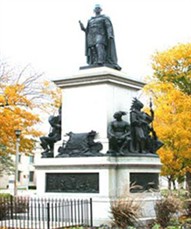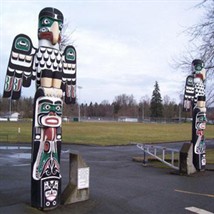A Breath of Fresh Air: Canada's Urban Parks
Whether they are large or small, urban parks provide solace and
fresh air to Canadians living in cities. These oases of green
first appeared during the 19th century, when town
planners decided to incorporate public squares into the urban grid
to counteract the disappearance of open spaces due to industrial
growth, and then later, urban sprawl. 
One of the oldest of these urban parks in Canada is Victoria Park Square in Brantford,
Ontario. It was created in 1830, landscaped in 1861, and
designed to be the focal point of the town. One of the finer
public squares in Canada, it is laid out to look like the British
Union Jack flag, has an elaborate drinking foundation made of
granite, and the diagonal pathways lead the visitor in to the
monument at the centre of the park. In 1886, this
monument was erected to commemorate First Nations leader Joseph
Brant (Thayendanega), for whom the town is named. The
monument is not just dedicated to Brant's memory, but includes a
group of life-sized statues representing the First Nations
communities that were once part of the Six Nations Alliance. Brant
and the Alliance played an important role in the American
Revolutionary War during the 1770s, helping to change the course of
history in North America. It is worth noting that Victoria Park
Square is part of a heritage conservation district, a district
which emphasizes the important relationship the park has with the
historic buildings surrounding it.
 Another historic urban
park is Riverview Memorial Park in Saint John, New
Brunswick. The park was originally constructed in 1902
as a memorial to soldiers from New Brunswick who participated in
the Boer War (1899-1902) in South Africa. This memorial function is
still upheld as soldiers still re-enact the 1900 battle of
Paardeberg each February 27th, in honour of the soldiers
from Saint John who died in battle. But the park is not just a
memorial to soldiers, it is also a lasting tribute to the
growing influence of women in Canada in the early years of the
20th century. So the park exists because a group
of local women belonging to the Women's Christian Temperance Union
of Saint John began a campaign to create a memorial park, and
collected funds from the community to do so. The end result
for an urban visitor is a place of contemplation, with a statue of
a lone soldier atop a monument with columns topped with Corinthian
capitals, landscaped pathways, and views of the St. John River.
Another historic urban
park is Riverview Memorial Park in Saint John, New
Brunswick. The park was originally constructed in 1902
as a memorial to soldiers from New Brunswick who participated in
the Boer War (1899-1902) in South Africa. This memorial function is
still upheld as soldiers still re-enact the 1900 battle of
Paardeberg each February 27th, in honour of the soldiers
from Saint John who died in battle. But the park is not just a
memorial to soldiers, it is also a lasting tribute to the
growing influence of women in Canada in the early years of the
20th century. So the park exists because a group
of local women belonging to the Women's Christian Temperance Union
of Saint John began a campaign to create a memorial park, and
collected funds from the community to do so. The end result
for an urban visitor is a place of contemplation, with a statue of
a lone soldier atop a monument with columns topped with Corinthian
capitals, landscaped pathways, and views of the St. John River.

Parks can draw people together, they can have memorials to
important people or events, or they have also been used as training
grounds for soldiers. This latter use is what happened in historic
Lewis Park in Courtenay, British Columbia.
While Lewis Park has functioned since 1893 as a community gathering
place and the spot for the annual Fall Fair, and has totem poles at
its entrance to marks the spiritual significance of the local First
Nations people, the park took on another role during the Second
World War. This was where the temporary barracks for the
"Fisherman's Reserve" were located. The reserve was a group of men
in the Canadian army who prepared for the possible expansion of the
war then raging in the eastern Pacific, and for the possible
invasion of the West Coast by the Japanese. The reservists
never had to deal with this reality, but they still trained on
assault craft kept in the nearby Courtenay River Slough. This
is also a picturesque place, sited to facilitate views of three
different rivers as well as to protect a variety of mature West
Coast trees.
By looking at a few of Canada's historic urban parks, we can see
how integral they are to their local communities, and how they are
much needed open spaces for cities. They are places to see and to
be seen, places to escape to and also to meet others, and they are
places with multiple uses and intentions. Both separate from
and intertwined with the cities that surround them, these historic
public spots are unique for the following reasons: they are free
and they are green, and you can probably walk to them. In our
busy world, that's a breath of fresh air!